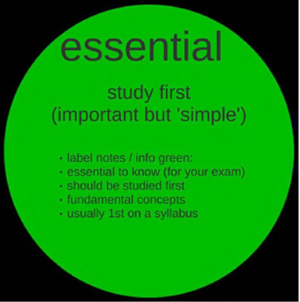9. Prioritisation
When studying a common pitfall people fall into is setting out to learn everything in the order in which is was presented or delivered. However, for a variety of reasons which could include time constraints, fatigue or sheer volume of material this may not be possible, or as you will see, even desirable. So, we need a method of separating what is essential you know, i.e. what is likely to make up the majority of your exam marks, from what would be great to know if you had unlimited time and energy.
One such method is the traffic light approach.
The Traffic light Approach
Green:
Take a green pen and mark everything that is essential to know for your exam. These topics should be studied first and will allow you to progress to the less number of amber and red topics. These green areas are often found first on a syllabus and may be the easiest concepts to learn but also the easiest to underestimate.
Amber:
Take an orange, gold, or even yellow pen and label everything that is either essential to know or is not too time consuming to learn. These items will form the mainstay of your learning and range from topics leading from the green to the red range of topics.
Red:
Take a red pen and label everything you would want to know if you had unlimited time and energy. Red topics should never be studied at the expense of the essential green and desired amber topics.
Red topics would include overly complicated ideas and subjects that may add one or two marks but will cost you a great deal of time and focus. By focusing on green and amber topics those that seemed red at the start may become more amber as time goes on.
This colour system visually reminds you to get moving and motivated on green topics and discourages wasting time on red ones. Additionally it provides a progressive learning system that is logical and less likely to become ‘bogged’ down in the minutiae.


